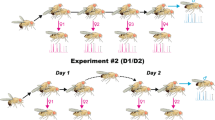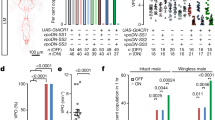Abstract
Virgin females of Drosophila melanogaster that are ectopically expressing the sex-pep-tide gene show a high level of ovulation and are unreceptive to males. However, if they are genetically deprived of eggs, receptivity is considerably restored (Fuyama, 1995). These females, whether they have eggs or not, extrude their ovipositors toward courting males as frequently as do fertilized females. However, this rejection behavior was ineffective in suppressing male courtship. Of females with eggs, about half of them could suppress male courtship. Females lacking eggs could not suppress male courtship and continued to elicit vigorous courtship. This difference seems to account for the increased mating frequency in sterilized females. Courtship behavior by mutant males defective in olfaction or learning suggested that females are capable of repelling males by emitting a volatile pheromone(s) with an inhibitory effect on male courtship.
Similar content being viewed by others
REFERENCES
Aigaki, T., Fleischmann, M., Chen, P. S., and Kubli, E. (1991). Ectopic expression of sex peptide alters reproductive behavior of female D. melanogaster. Neuron 7:557–563.
Busson, D., Gans, M., Komitopoulou, K., and Masson, M. (1983). Genetic analysis of three dominant female sterile mutations located on the X chromosome of Drosophila melanogaster. Genetics 105:309–325.
Chen, P. S. (1984). The functional morphology and biochemistry of insect male accessory glands and their secretions. Annu. Rev. Entomol. 29:233–255.
Connolly, K., and Cook, R. (1973). Rejection response by female Drosophila melanogaster: Their ontogeny, causality and effects upon the behaviour of the courting male. Behaviour 44:142–166.
Fuyama, Y. (1995). Genetic evidence that ovulation reduces sexual receptivity in Drosophila melanogaster females. Behav. Genet. 25:581–587.
Jallon, J.-M. (1984). A few chemical words exchanged by Drosophila during courtship and mating. Behav. Genet. 14:441–478.
Jallon, J.-M., Benamar, O., Luyten, I., and Anthony, C. (1982). Modulation de la production des hydrocarbures cuticulaires des Drosophilides resultant de perturbation genetiques et physiologiques. In Descoins, C. (ed.), Colloques de l'INRA No. 7, pp. 297–302.
Kubli, E. (1992). The sex-peptide. BioEssays 14:779–784.
Leopold, R. A. (1976). The role of male accessory glands in insect reproduction. Annu. Rev. Entomol. 21:199–221.
Lindsley, D. L., and Zimm, G. G. (1992). The Genome of Drosophila melanogaster, Academic Press, San Diego.
Nakayama, S., Kaiser, K., and Aigaki, T. (1997). Ectopic expression of sex-peptide in a variety of tissues in Drosophila females using the P[GAL4] enhancer trap system. Mol. Gen. Genet. 254:449–445.
Schmidt, T., Choffat, Y., Klauser, S., and Kubli, E. (1993). The Drosophila melanogaster sex-peptide: A molecular analysis of structure-function relationships. J. Insect Physiol. 39:361–368.
Scott, D., and Richmond, R. C. (1987). Evidence against an antiaphrodisiac role for cis-vaccenyl acetate in Drosophila melanogaster. J. Insect Physiol. 33:363–369.
Siegel, R. W., Hall, J. C., Gailey, D. A., and Kyriakou, C. P. (1984). Genetic elements of courtship in Drosophila: Mosaics and learning mutants. Behav. Genet. 14:383–410.
Tompkins, L. (1984). Genetic analysis of sex appeal in Drosophila. Behav. Genet. 14:411–440.
Tompkins, L., and Hall, J. C. (1981). The different effects on courtship of volatile compounds from mated and virgin Drosophila females. J. Insect Physiol. 27:17–21.
Tompkins, L., Hall, J. C., and Hall, L. M. (1980). Courtship-stimulating volatile compounds from normal and mutant Drosophila. J. Insect Physiol. 26:689–697.
Vander Meer, R. K., Obin, M. S., Zawistoski, S., Sheehan, K. B., and Richmond, R. C. (1986). A reevaluation of the role of cis-vaccenyl acetate, cis-vaccenol and esterase 6 in the regulation of mated female sexual attractiveness in Drosophila melanogaster. J. Insect Physiol. 32:681–686.
Author information
Authors and Affiliations
Rights and permissions
About this article
Cite this article
Fuyama, Y., Ueyama, M. Ovulation and the Suppression of Mating in Drosophila melanogaster Females: Behavioral Basis. Behav Genet 27, 483–488 (1997). https://doi.org/10.1023/A:1025630602057
Issue Date:
DOI: https://doi.org/10.1023/A:1025630602057




